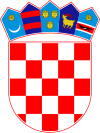This article needs additional citations for verification. (September 2009) |
| History of Croatia |
|---|
 |
| Timeline |
|
|
| History of Slavonia |
|---|
 |
Ban of Slavonia (Croatian: Slavonski ban; Hungarian: szlavón bán; Latin: Sclavoniæ banus) sometimes also Ban of "Whole Slavonia" (Croatian: ban cijele Slavonije; Hungarian: egész Szlavónia bánja; Latin: totius Sclavoniæ banus),[1] was the title of the governor of a territory part of the medieval Kingdom of Hungary and Kingdom of Croatia.
From 1102, the title Ban of Croatia was appointed by the kings of Hungary, and there was at first a single ban for all of the Kingdom of Croatia and Dalmatia, but later the Slavonian domain got a separate ban. It included parts of present-day Central Croatia, western Slavonia and parts of northern Bosnia and Herzegovina. From 1225, the title started being held by a separate dignitary from the title of the Ban of Croatia and Dalmatia, and existed until 1476, when it was joined with the latter title.
In the 13th and 14th centuries, the more extensive title of Duke of Slavonia (meaning all lands of the Kingdom of Croatia and Dalmatia and Slavonian domain[2]) was granted, mainly to relatives of Hungarian monarchs or other major noblemen.
According to the public law of the Kingdom of Hungary, bans were counted among the "barons of the realm" and thus they enjoyed several privileges connected to their office.
- ^ Heka, László (2023). "Hrvatski ban: prava i ovlasti tijekom tisućgodišnje opstojnosti: mađarska ustavno-povijesna perspektiva". Zbornik Pravnog fakulteta Sveučilišta u Rijeci (in Croatian). 44 (2): 437. doi:10.30925/zpfsr.44.2.7. Retrieved 26 September 2024.
- ^ Božić, Mate; Ćosić, Stjepan (2017). "Nastanak hrvatskih grbova: Podrijetlo, povijest i simbolika od 13. do 16. stoljeća". Gordogan (in Croatian). Vol. 15, no. 34. Novi Gordogan, udruga za kulturu, Zagreb. p. 27. Retrieved 9 January 2025.
